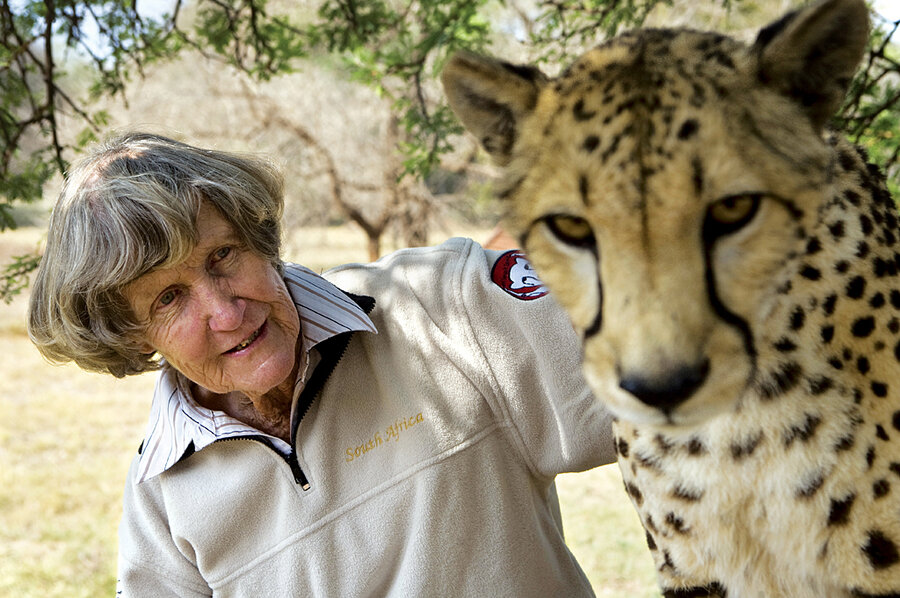The big cats' best friend
Loading...
| Hartbeestport, South Africa
There are cat people, and then there is Ann van Dyk. Living on her family’s farm north of Pretoria, she bought two cheetah cubs from a local farmer – much as any farm girl might take in a stray dog or cat – only to have them confiscated because they were an endangered species.
Chastened but unbowed, she and her brother would eventually offer 99 acres of their family’s farmland to the National Zoological Gardens of South Africa in Pretoria, which had a cheetah breeding program but needed rural land in order to expand it.
So in 1971, the De Wildt Cheetah and Wildlife Centre (recently renamed the Ann van Dyk Cheetah Centre) was born. Its goal: Breeding cheetahs and educating native farmers about their value.
“I think the fact that cheetahs are an endangered species, and nobody was doing anything about it, that was the reason I started this center,” says Ms. Van Dyk, now in her 70s but still very much like the idealistic girl who started the center.
There were no books about how to raise cheetahs, she says with a smile. “It was very much hit-and-miss. We just put up camps for the cheetahs and slowly learned what was required.”
Today there are perhaps 7,500 cheetahs left in the wild, down from 100,000 around the turn of the 20th century, and some scientists believe that cheetahs could become extinct within the next 15 years. In the past, hunting and farming were the big cats’ main enemies, but now their numbers are so small that scientists worry about the dangers of inbreeding among those who survive.
What is needed is land and lots of it – without sufficient land in which to roam, cheetahs go into a kind of neurotic depression and stop breeding. This is where conservationists like Ann van Dyk can make a difference.
Van Dyk isn’t the only conservationist to successfully breed cheetahs, but few can match her numbers. Since 1971, she has bred 800 of the big cats, some of them tagged and released into the wild and others sent to zoos.
This success has won her respect from zoo authorities and other conservationists. In 2004, the Cheetah Conservation Fund named Van Dyk as Cheetah Conservationist of the Year, saying that her “years of dedicated work in South Africa exemplify how conservation has evolved” and calling her organization “one of the most successful breeding centers in the world.”
IN PICTURES: A Sanctuary for Cheetahs
But she has drawn some hostility from local farmers, some of whom still shoot wild cheetahs as a threat to their livestock.
“Cheetahs take their livestock, so you have to look from their point of view,” says Van Dyk of the farmers. But because her center offers to capture and remove cheetahs from their property free of charge, some see Van Dyk and her conservationists as allies.
“You can never put a wild-caught cheetah into a captive situation,” she says. “We’ll take them in, but usually we’ll relocate them to a game park. And it’s been a great success; they are breeding.”
Van Dyk walks into a pen belonging to a cheetah named Big Girl. The cat recognizes Van Dyk, and after a few strokes on the head and under the chin, Big Girl settles into Van Dyk’s lap, purring. At this point, Van Dyk tells some visitors that they can come into the pen as well.
“Now, I have great admiration for the leopard,” she says, “but you will never get that look of trust that you get with a cheetah.”
She points at Big Girl’s face, which seems as relaxed and contented as a tabby cat’s – albeit a large one. “A leopard will look at you with a cold eye – ‘I’m going to have you for supper.’ A cheetah looks at you the way a child does.”
If Van Dyk feels a bit maternalistic about her cheetahs, it’s understandable. In a sense she’s been midwife to nearly 800 of them.
Visitors to her center are given equal parts love and caution. “Please don’t feel tempted to pet the cheetahs,” one guide says to a group. “And please don’t bend down to take pictures. Cheetahs don’t generally attack and eat people, but when you bend down, you can possibly look like their prey.”
There is one cheetah at the center that everyone, even children, is encouraged to pet. His name is Byron.
“Byron doesn’t even know what a cage is,” says Marilyn Hull, general manager of the center, who often takes him to schools around South Africa to educate children about the need to conserve cheetahs. “At hotels, he sleeps in the same bed with you.”
Like other cheetah reserves – such as the Cheetah Conservation Fund in Namibia Cheetah Conservation Botswana and Cheetah Outreach in Stellenbosch, South Africa – the Ann van Dyk Cheetah Centre has begun a breeding program for Anatolian shepherd dogs, which are given to local sheep farmers to help ward off predators such as cheetahs, so there’s less temptation to shoot the big cats.
Van Dyk knows it will take a monumental effort to prevent cheetahs from becoming extinct, but says it must be done. “Cheetahs have been on the planet for so long that we should not let [them] die out now.”
Like many animal lovers, Van Dyk occasionally despairs of that predator known as Homo sapiens. But anyone who has put so much energy into preserving animals cannot be a pessimist. “I’ve got a great team,” she says, “and when I’m not here anymore, they’ll carry it forward.”
IN PICTURES: A Sanctuary for Cheetahs
-----





